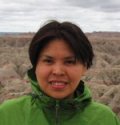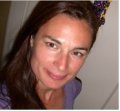
clarita@u.washington.edu

|
Clarita Lefthand
clarita@u.washington.edu |
| My project uses microbial source tracking methods to determine sources of fecal contamination of water on the Tulalip Reservation. The Tulalip Reservation is located 41 miles north of Seattle, Washington on the coast of Puget Sound. There are over 3600 members from six allied tribes which in combination make up the population of the Tulalip reservation. These tribal groups share a strong interest in the preservation of their traditional cultures including a close spiritual, economical, and healthful connection with the Puget Sound. Tulalip Bay (TB) connects to the Puget Sound and has served as a significant area for members to gather shellfish and other seafood, conduct community ceremonies and swim. Today, the TB is closed to shellfish harvesting and recreational use due to elevated levels of fecal contamination. Potential fecal contamination sources are water fowl, seals, dogs, and failing sewer systems. My projects aims to differentiate between three potential sources: human, ruminant, and dog at 13 sites located inside or outside of TB. Two Microbial Source Tracking (MST) methods will be used to determine the presence of fecal material from these species. F + Specific Coliphage detection and Bacteriodes 16S rRNA detection will be used simultaneously to detect human and non-human fecal material and human, ruminate and dog fecal matter, respectively. Host specific gene probes and/or primers will be used to detect the presence of each of these sources. The use of two MST approaches is meant to substantiate the results of each method. Water samples will be collected monthly at each of the 13 sites beginning in mid-July 2006 and ending May 2007. |

|
Eyob
eyob@u.washington.edu |
| about Eyob's project |

|
Hamilton Bennett
hamilton.bb@gmail.com |
| about Eyob's project |
|
|
Sarah Dabagh
sarah.dabagh@gmail.com |
| dabagh's paragraph |
|
|
Lauren Dunbar
dunbal@u.washington.edu |
| Dunbar's paragraph |
|
|
Kelly Jones
kellyjones81@gmail.com |
| Kelly's paragraph |
|
|
Christina M Rohlik
c.rohlik@gmail.com |
| Christina Rohlik is an graduate student working in the Environmental Microbiology lab at the University of Washington under investigators Dr. John Scott Meschke and Dr. Gwy-Am Shin. |
|
|
Winnie winnieuw@u.washington.edu |
| I am currently a senior undergraduate student in the Microbiology Department and will graduate in June 2008 with a B.S. in Microbiology. I have been working with graduate student Jennifer Parker on the EPA-funded Direct Detect project in Dr. Scott Meschke’s Environmental and Occupational Health Microbiology Lab since Spring 2007. Research responsibilities include maintaining cell cultures, DNA extractions, and qPCR to detect DNA from environmental pathogens in water samples. I wish to pursue my future study in environmental protection. | |
|
|
Lorena Ray rayl@u.washington.edu |
| | Ray is curruntly working with...
|
Past Graduate Students
|
|
Lesley Leggett, MS lalissima@gmail.com |
| What is Lesley doing now? |
|
|
Jennifer Parker, MS jenniferkparker@gmail.com |
| What is Jennifer Parker doing now? |
|
|
Laura McLaughlin, MS laurita6@u.washington.edu |
| Laura graduated from the Environmental Health Department in June 2006. She continues working with the Meschke-Shin Lab from Finland as part of the Valle Exchange Program . At the UW, she did her research on drinking water treatment options for rural areas of less developed countries, focusing on chlorine use and UV disinfection. The field portion of her thesis work was done on chlorine use in the Borbon Region of Ecuador, in conjunction with UC Berkeley's EcoDeSS Project. The UV portion of her thesis evaluated efficacy of the MEDRIX UV disinfection system for use under varying water quality conditions. |

|
Kristin L. Cunningham, MS |
| Kristin received her Master's degree from the Department of Environmental and Occupational Health Sciences at the University of Washington in June 2005. In the Meschke-Shin Laboratory, Kristin conducted research on environmental contamination, transmission, and ensuing human health effects of increasingly common nosocomial bacteria (Methicillin-resistant Staphylococcus aureus and Vancomycin-resistant Enterococci) and persistent viruses (Norovirus, Poliovirus, and Feline Calicivirus). Kristin was responsible for developing and maintaining growth media and cell cultures, conducting bacterial and viral assays, and executing disinfection experiments. Kristin interpreted experimental results to determine the efficacy of pathogen inactivation on environmental surfaces using a newly developed disinfectant. She obtained a scholarship to attend and present her results at the National Environmental Health Association's Annual Educational Conference. Since graduating, Kristin has been working for RIDOLFI, Inc., which is a small Seattle-based environmental and engineering consulting firm committed to the effective management and protection of natural resources and sustainable site development. As an Environmental Risk Assessor, Kristin combines her M.S. in Environmental Health (risk emphasis) with her past experience as an environmental scientist to work on projects involving the characterization of contaminated sites and evaluation of potential risks to human health and ecological receptors on behalf of the National Oceanic and Atmospheric Administration and Native American Tribes. |

|
Heather Day, MS |
| Heather Day (formerly Heather Bost) is currently living in Troy, NY, and working on her Master of Arts in Teaching Biology at Sage College, while her husband completes postdoctoral training at the Rensselaer Polytechnic Institute (RPI). Heather is currently teaching an undergraduate Microbiology Lab at Sage, and working with elementary aged children as the Environmental Educator at Dyken Pond, a county park and education center. She recently published an article, "An Evaluation of the Alignment of New York State's Living Environment Mandated Lab Activities to the MST Standards," in the Science Teachers' Association of New York State's Spring 2006 Science Teachers Bulletin. She is interested in helping students learn about the scientific process, and is currently working with her coauthor, Dr. Dorothy Matthews, on another article investigating the way in which scientific inquiry is assessed on standardized tests. When she isn't busy teaching and being a student, Heather is enjoying exploring New York's beautiful outdoors. |
Past Undergraduates
|
|
Eric Coker rickeyrulz@yahoo.com |
|
Update: Eric is now a graduate student under Mike Yost! Eric Coker works under the advisement of Dr. Scott Meschke as lab assistant in the Environmental Health Microbiology lab. Current laboratory research includes microbial source typing for recreational waters. Much of this work relies upon specific culture and genetic testing for coliphage as an indicator for the microbial water quality. Water sampling of marine environments is also one aspect of Eric's work. |
|
|
Henry Doan henryd2@u.washington.edu |
| Project: biofilm trap A biofilm trap consists of a device that water containing pathogen can flow past biofilms, providing the potential for the pathogen to attach to the biofilm or become entrapped in the biofilm. After time, the biofilm is removed and sampled to determine the presence of pathogens that may have been in the water trapped by the biofilm. Project: UV purification system Work with Derrick you, under the supervision of Laura. The UV system consists of a UV light bulb and a water box, which allow water to flow past the UV bulb. Samples are collected at the inlet and outlet and they will be used in membrane filtration. These filters will be grown on selected media. |
|
|
Brandt Pein peinb@u.washington.edu |
| I applied for an internship through the STAR program in late spring and was accepted to work in Dr. Meschke's lab for the summer of 2006. Throughout the summer I have worked on many projects in both the Meschke lab and Marilyn Robert's lab. My projects at Dr. Meschke's lab included microbial source tracking in Tulalip Reservation and Oakland Bay, and analyzing water fountain samples from local restaurants via microbial filtration. The work in these projects consisted of going into the field to collect water samples and running both single agar layer and two-step enrichment assays to detect fecal coliphage. My project at Dr. Robert's lab consisted of the isolation, detection and quantification of bacterial mRNA to find a link between phenotypic and genotypic antibiotic expression. |
|
|
Derrick You dyou@u.washington.edu |
| Over the course of the past three months a UV-disinfection system to be used as a point-of-use treatment option in Vietnam has been explored. This project is a continuation of Laura McLaughlin's thesis and aims to address some unanswered questions. The UV system consists of a metal housing in which a UV lamp and ballast are attached. This system is built entirely of materials easily accessible in many parts of the world and can be easily built. The system basically consists of untreated water that flows through a metal housing containing the UV light where the water is treated and then stored in another container for future use. The mechanism behind UV disinfection involves the joining of neighboring thymine dimmers in the target for removal causing errors in DNA replication. Efficacy of the system was determined by log removals of seeded coliphage, E. coli and enterococci, based on inlet and outlet samples. Clear buffered water, low and high turbid water, and low and high iron concentrations were also used to determine the effect of such solutions on log removals. For future experiments a slow sand filter incorporated into the system will be tested to see if such an addition can increase the efficacy of the UV system. This system hopes to prevent diarrheal disease in many developing countries where millions of children fall victim to this second most common cause of death. |